A biweekly newsletter with public space news, resources, and opportunities.
A curated dispatch on all things public markets plus the latest announcements from the Market Cities Program.
OPPORTUNITY: A Market City helps vendors, especially those facing systemic injustices, to start a new business or expand an existing one.
–7 Principles for Becoming a Market City
While public markets are known for offering everything from fresh food to artisanal goods, they also present aspiring vendors with the chance to start their own business. Because they have lower barriers to entry than traditional brick-and-mortars, many farmers and entrepreneurs, including those from marginalized communities, have been able to get their start at a public market.

Even so, getting to market is not always easy. Systemic barriers like land access, permitting, and other complicated legal processes often stand in the way of aspiring farmers and makers. Luckily, many public markets and related organizations are changing the game for aspiring entrepreneurs, providing direct support in the form of legal services, access to microcredit, training, and even pushing cities to create a better environment for market newcomers. After all, in a time when the population of farmers is aging and succession is a concern for small businesses, a community can help sustain its local economy by supporting existing business owners and making way for the generation that follows.
In this article, we’ll explore how cities including Tulsa, New York, and London are experimenting with new ways of ensuring that more people, especially those from communities that face barriers and discrimination based on race, immigration status, or language, have the opportunity to start market-based businesses. Beyond serving as a space to sell, markets in these three cities are home to initiatives that train, support, and advocate for the well-being of vendors. Following their example, we can create Market Cities that put opportunity at the center of the public market ecosystem.
In Tulsa, Oklahoma, entrepreneurs are getting a boost thanks to the city’s first food incubator. A local program called Kitchen 66 has supported more than 70 participants as they navigate the process of starting a food business, providing training and commercial kitchen space along the way. As one of the earliest components of what is now Mother Road Market, Kitchen 66 has earned its reputation as Tulsa’s “kickstart kitchen,” launching countless businesses and careers in food.

Founded in 2016 as a commercial kitchen space, Kitchen 66 soon added its Launch Program—a 12-week course covering all aspects of opening a food business apart from the culinary one—with scholarships. Training covers many of the biggest challenges that new business owners face in getting their endeavors off the ground, including sales, public relations, and marketing. It soon became clear to Kitchen 66, that their program was offering opportunities for immigrants, ESL speakers, and other marginalized groups.

In 2021, Kitchen 66’s programs expanded to include a sister program called Cocina 66 featuring a translated curriculum for Spanish-speaking participants. Bringing in community leaders and other local nonprofits like UMA Tulsa, the expansion has almost doubled the capacity of the program.

Program graduates often go on to have a long-term presence at Mother Road Market. In fact, viable businesses coming out of Kitchen 66 are part of what Thompson refers to as the “genesis of the market,” which was one of the first food halls in Oklahoma when it started in 2018. This includes graduates like Faith Walker, who has gone on to establish her business, Curds and Whey, at Mother Road Market.
Thompson emphasized the intentionality of vendor selection at the market and recalls that Faith was Mother Road Market’s first Black-owned business when it opened in 2021. “Whenever we have a vacancy at the market, we look to recent Kitchen 66 program graduates first,” says Thompson. Currently, Faith’s sales are growing, which is always empowering for a new business owner. The market management team’s long-term attention to the well-being of vendors, from training to sustaining a business, is a key part of their program’s success.
Thanks to programs like GrowNYC, New York City has become an unexpectedly great place for farmers to start a business through its markets and related initiatives. In addition to overseeing more than 50 Greenmarkets across New York City since the 1970s, GrowNYC has worked to lift barriers for farmers through its Farmer Assistance program. Since 2000, the program has served both new and experienced farmers, launching many farmers to long-term presence at a public market and helping others to do the hard work of sustaining their market business over time.
GrowNYC’s Assistant Director for Regional Agriculture Tracy Lerman notes that the program, originally called the New Farmer Development Program, “recognized that providing a farmers market is a good first step to supporting farmers, but they need other types of support.” Now, the Farmer Assistance program offers training for new farmers, as well as skills workshops, legal and technical support, and advocacy around systemic barriers.

Twice each year, anywhere from 30 to 50 farmers get an in-depth course in enterprise planning, record keeping, budgeting, and farm policies through a training program called Farm Beginnings / La Nueva Siembra. As a result of training opportunities like this, 48 farmers have begun independent farm businesses selling a wide variety of products including cut flowers, honey, fruits, vegetables, and herbs. More specific skills workshops are offered at other times, digging into best practices in marketing or practical production topics. Beyond offering this type of training in Spanish as well as English, GrowNYC is actively pursuing grants to examine themes like language justice and building a list of technical assistance providers who have the cultural competency to serve their Latinx vendors.

Through GrowNYC’s partnership with the Pace University Food and Beverage Law Clinic, the program also provides technical and legal support to farmers including lease negotiations, succession planning, and real estate dealings. This legal work complements the marketing assistance that farmers can access through the program, which includes everything farmers need to have the “best market tent possible,” from help with signage to support in developing new products and even analyzing customer behavior.
For farmers in need of new equipment, GrowNYC provides access to micro-loans as a trustee for the nonprofit Kiva. GrowNYC staff endorse both Farm Beginnings participants and established Greenmarket farmers as they apply for loans of up to $15,000—expanding access to practical financial resources.
Through nearly half a century of experience managing a markets system, GrowNYC learned the importance of providing training and services to meet their full potential. Today, it continues to look beyond its direct work with farmers and vendors to actively participate in advocating for systemic change to land access, especially for farmers in historically underrepresented communities.
“I am interested in our growth being done in a way that does not step on the work of other less-resourced or BIPOC-led organizations,” says Lerman. “People have been working on land access for decades and we want to make sure we uplift that work and that we are good allies.”
In London, a city of more than 300 public markets, a program run by the Mayor of London’s Regeneration Team is designing a new future for market vendors (or “traders,” as they call them locally). As part of a broader agenda for High Streets and Town Centers, street markets are the focus of an ongoing program called Tomorrow’s Market, which aims to nurture a new generation of market traders.

With the announcement of a groundbreaking city-wide markets policy as well as the 10th International Public Markets Conference, 2019 was a pivotal year for London’s markets. It also marked the first phase of the two-year Tomorrow’s Market pilot program to give vendors a boost in getting their businesses up and running and address some of the barriers they face.
To start, aspiring vendors in London are often met with inconsistencies for entry requirements across the city’s markets. On top of that, as Regeneration Team member Tina Jadav notes, “younger generations aren’t picking up the family business. There is a slight anxiety in the more traditional forms of trading, like watch-fixing or butchery. There’s less uptake from young people to follow in those types of trades.” As one of the core team members working on the Mayor’s Markets Agenda, overseen by the London Markets Board, Jadav developed the Tomorrow’s Markets curriculum with these challenges in mind.
The pilot was based on the idea of offering cohorts of aspiring market traders a six-month course focused on business support, including training in marketing and social media. The pilot program was meant to fill the gaps in vendor support through a comprehensive business incubator designed to bring a diverse new set of vendors to the city’s public markets.
In all, the pilot consisted of two waves of this support, given to a total of 30 traders, who had access to tailored training, seminars, and networking activities. As early as the second week of the training, Jadav notes that participants were guided towards hands-on learning. “They were at a market, learning while doing.” Today, it seems that this incubation approach has paid off: 28 of the participating traders continue selling either in markets, online, or on High Streets.
Because of the success of the program, the natural next step is to share these approaches more widely. Today, the follow-up program, Tomorrow’s Market 2.0, centers on sharing the takeaways from the pilot program, distilling lessons learned into a useful best practice guide. The guide will help market operators in other cities and towns elevate public markets by implementing their own business incubation models. Even though the best practice guide is still in the works, the ideas of Tomorrow’s Markets are already catching on. Dean notes that places like Chapel Market are testing out markets with new traders, layouts, and uses of space, and monitoring the results via metrics like foot traffic.

According to Megan Dean, another member of the Regeneration Team who is directing Tomorrow’s Market 2.0, the follow-up program is also part of Mayor Sadiq Khan’s London Recovery Board, embedding markets into wider strategies that support innovative business incubation. Direct support for vendors has now transitioned into work with market operators to improve the economic environment for markets through one-on-one workshops and seminars on themes like legislation and the circular economy.
As the Greater London Authority demonstrates, municipalities have the power to harness the capacity of markets to drive inclusive forms of entrepreneurship. Whether it’s through research, governance, incubator programs, or integrated policies, the public sector has a vital role to play in cultivating a Market City.
Opportunity in public markets is all about tearing down barriers, building up supportive scaffolding, and laying a solid policy foundation for market managers and vendors. Tulsa, New York, and London offer a glimpse of just a few of the tools that governments and market support organizations can use to harness the entrepreneurial energy in our market systems.
When public markets are open to new business ideas and actively work to support entrepreneurs, vendors, and aspiring farmers, we all benefit. Whether from a boosted local economy, improved economic equity, or simply a wider array of options when we are choosing what to eat next, better opportunities mean better Market Cities for all.
Katherine Peinhardt has a background in climate change, and writes about the intersection of resilience and placemaking. She currently works at the ICLEI European Secretariat, and is a former German Chancellor Scholar.
The rich text element allows you to create and format headings, paragraphs, blockquotes, images, and video all in one place instead of having to add and format them individually. Just double-click and easily create content.
The rich text element allows you to create and format headings, paragraphs, blockquotes, images, and video all in one place instead of having to add and format them individually. Just double-click and easily create content.
Body Text Body Link
The rich text element allows you to create and format headings, paragraphs, blockquotes, images, and video all in one place instead of having to add and format them individually. Just double-click and easily create content.
Here is some highlighted text from the article.




Headings, paragraphs, blockquotes, figures, images, and figure captions can all be styled after a class is added to the rich text element using the "When inside of" nested selector system.
Headings, paragraphs, blockquotes, figures, images, and figure captions can all be styled after a class is added to the rich text element using the "When inside of" nested selector system.
Headings, paragraphs, blockquotes, figures, images, and figure captions can all be styled after a class is added to the rich text element using the "When inside of" nested selector system.

We are committed to access to quality content that advances the placemaking cause—and your support makes that possible. If this article informed, inspired, or helped you, please consider making a quick donation. Every contribution helps!
Project for Public Spaces is a 501(c)(3) tax-exempt organization and your donation is tax-deductible within the guidelines of U.S. law.